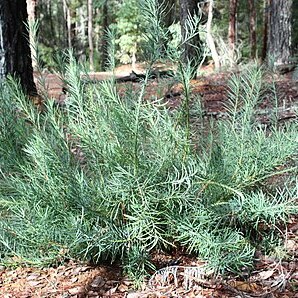Shrub to 3 m tall, multi-stemmed and sprouting from the rootstock. Stems erect. Bark thin, fibrous. Resting leaf buds conical, 1.5-3 mm diam., 2-4 mm long; scales narrowly triangular, with fine, spreading tips. Adult leaves linear, sessile and broad-based, 3-12 cm long, 2-6 mm wide, acuminate, green above, glaucous beneath; midrib almost flat on upper surface, prominent below; 1 resin duct present below vascular bundle; upper hypodermis interrupted. Male cones broadly cylindrical, 4-10 mm long, 3-5 mm diam., axillary in groups of 1-6; each cone on a scaly peduncle 10-25 mm long; microsporophylls imbricate, finely apiculate. Female cones of 1 fertile scale with 1 or 2 ovules, axillary on peduncles to 20 mm long; receptacle to 25 mm long, fleshy, purple at maturity, subtended by 2 deciduous bracts 2-10 mm long. Mature seed ovoid, 10-19 mm long, 7-15 mm diam., not crested.
More
A shrub or small tree. It grows 3 m high. It spreads to 0.5-2.5 m wide. It has creeping underground stems. The leaves are narrow and pale green. They are 4-11 cm long by 0.5 cm wide. They are alternate and crowded. The edges curve back. Male and female cones are produced on different plants. The male cones are 0.5-1.2 cm long by 0.5 cm wide. They usually occur singly. The female cone is 1.5 cm long and occurs singly. The stalk of the cone becomes fleshy and swollen. These fruit are large. They are edible. The single round seed, or cone, is attached to a fleshy "stalk" which is like a large purple grape.


